Duties of a Nurse
VerifiedAdded on 2023/01/13
|18
|4346
|77
AI Summary
This document discusses the duties of a nurse, focusing on prioritizing patient care, interventions for dyspnea and tachycardia, and managing complications after knee replacement surgery. It includes case studies with responses to questions and provides valuable study material and assignments on the topic.
Contribute Materials
Your contribution can guide someone’s learning journey. Share your
documents today.
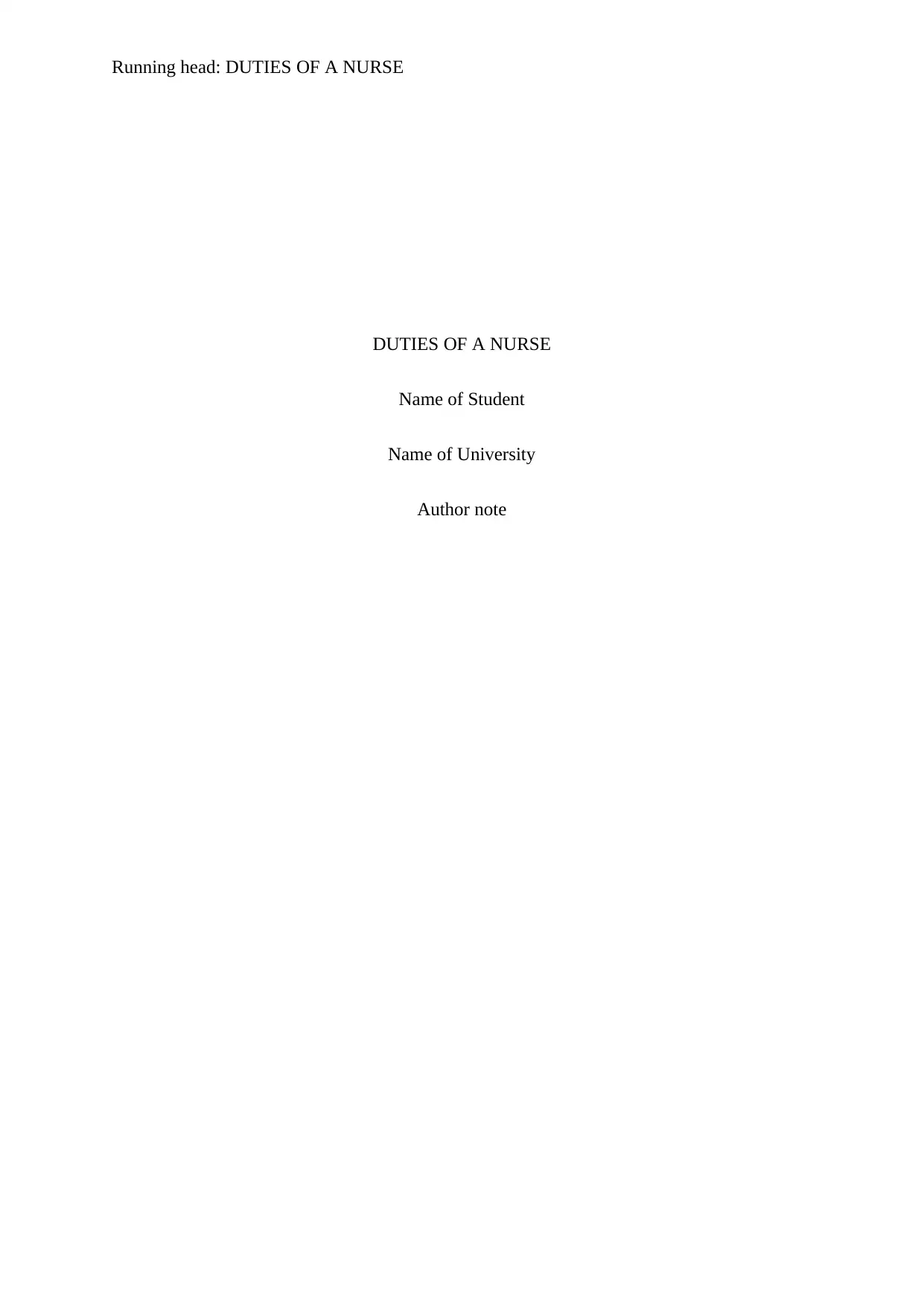
Running head: DUTIES OF A NURSE
DUTIES OF A NURSE
Name of Student
Name of University
Author note
DUTIES OF A NURSE
Name of Student
Name of University
Author note
Secure Best Marks with AI Grader
Need help grading? Try our AI Grader for instant feedback on your assignments.
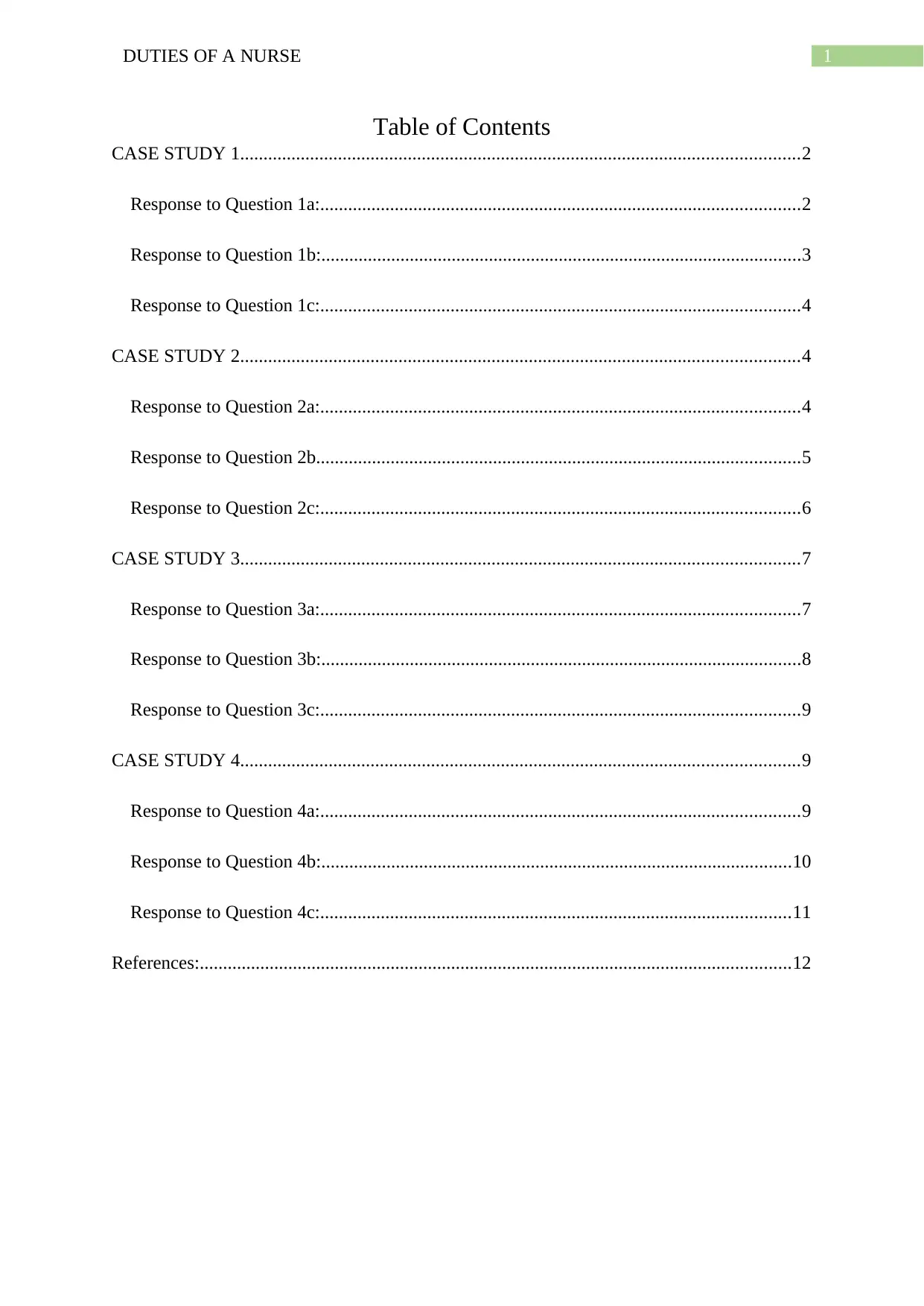
1DUTIES OF A NURSE
Table of Contents
CASE STUDY 1........................................................................................................................2
Response to Question 1a:.......................................................................................................2
Response to Question 1b:.......................................................................................................3
Response to Question 1c:.......................................................................................................4
CASE STUDY 2........................................................................................................................4
Response to Question 2a:.......................................................................................................4
Response to Question 2b........................................................................................................5
Response to Question 2c:.......................................................................................................6
CASE STUDY 3........................................................................................................................7
Response to Question 3a:.......................................................................................................7
Response to Question 3b:.......................................................................................................8
Response to Question 3c:.......................................................................................................9
CASE STUDY 4........................................................................................................................9
Response to Question 4a:.......................................................................................................9
Response to Question 4b:.....................................................................................................10
Response to Question 4c:.....................................................................................................11
References:...............................................................................................................................12
Table of Contents
CASE STUDY 1........................................................................................................................2
Response to Question 1a:.......................................................................................................2
Response to Question 1b:.......................................................................................................3
Response to Question 1c:.......................................................................................................4
CASE STUDY 2........................................................................................................................4
Response to Question 2a:.......................................................................................................4
Response to Question 2b........................................................................................................5
Response to Question 2c:.......................................................................................................6
CASE STUDY 3........................................................................................................................7
Response to Question 3a:.......................................................................................................7
Response to Question 3b:.......................................................................................................8
Response to Question 3c:.......................................................................................................9
CASE STUDY 4........................................................................................................................9
Response to Question 4a:.......................................................................................................9
Response to Question 4b:.....................................................................................................10
Response to Question 4c:.....................................................................................................11
References:...............................................................................................................................12
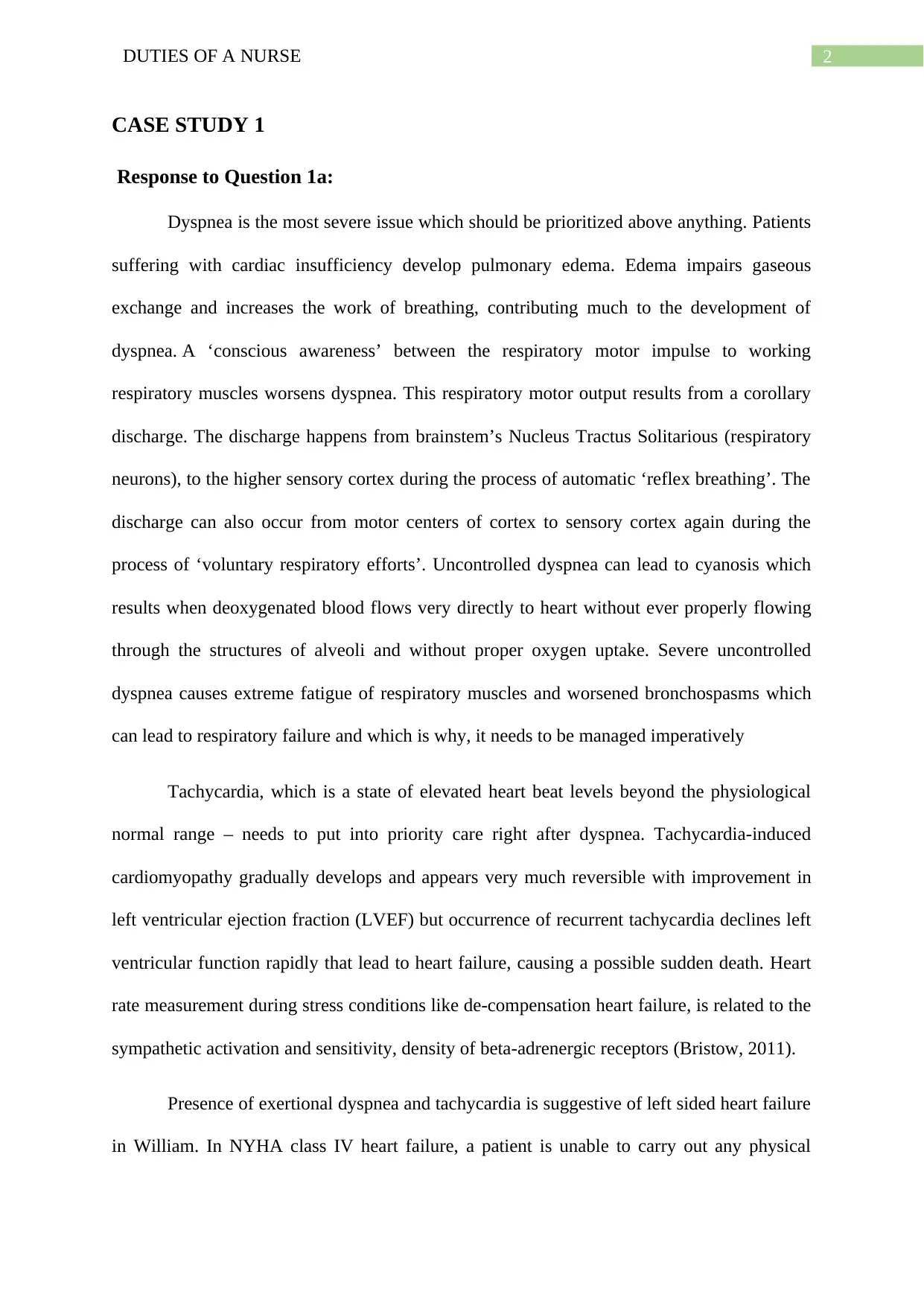
2DUTIES OF A NURSE
CASE STUDY 1
Response to Question 1a:
Dyspnea is the most severe issue which should be prioritized above anything. Patients
suffering with cardiac insufficiency develop pulmonary edema. Edema impairs gaseous
exchange and increases the work of breathing, contributing much to the development of
dyspnea. A ‘conscious awareness’ between the respiratory motor impulse to working
respiratory muscles worsens dyspnea. This respiratory motor output results from a corollary
discharge. The discharge happens from brainstem’s Nucleus Tractus Solitarious (respiratory
neurons), to the higher sensory cortex during the process of automatic ‘reflex breathing’. The
discharge can also occur from motor centers of cortex to sensory cortex again during the
process of ‘voluntary respiratory efforts’. Uncontrolled dyspnea can lead to cyanosis which
results when deoxygenated blood flows very directly to heart without ever properly flowing
through the structures of alveoli and without proper oxygen uptake. Severe uncontrolled
dyspnea causes extreme fatigue of respiratory muscles and worsened bronchospasms which
can lead to respiratory failure and which is why, it needs to be managed imperatively
Tachycardia, which is a state of elevated heart beat levels beyond the physiological
normal range – needs to put into priority care right after dyspnea. Tachycardia-induced
cardiomyopathy gradually develops and appears very much reversible with improvement in
left ventricular ejection fraction (LVEF) but occurrence of recurrent tachycardia declines left
ventricular function rapidly that lead to heart failure, causing a possible sudden death. Heart
rate measurement during stress conditions like de-compensation heart failure, is related to the
sympathetic activation and sensitivity, density of beta-adrenergic receptors (Bristow, 2011).
Presence of exertional dyspnea and tachycardia is suggestive of left sided heart failure
in William. In NYHA class IV heart failure, a patient is unable to carry out any physical
CASE STUDY 1
Response to Question 1a:
Dyspnea is the most severe issue which should be prioritized above anything. Patients
suffering with cardiac insufficiency develop pulmonary edema. Edema impairs gaseous
exchange and increases the work of breathing, contributing much to the development of
dyspnea. A ‘conscious awareness’ between the respiratory motor impulse to working
respiratory muscles worsens dyspnea. This respiratory motor output results from a corollary
discharge. The discharge happens from brainstem’s Nucleus Tractus Solitarious (respiratory
neurons), to the higher sensory cortex during the process of automatic ‘reflex breathing’. The
discharge can also occur from motor centers of cortex to sensory cortex again during the
process of ‘voluntary respiratory efforts’. Uncontrolled dyspnea can lead to cyanosis which
results when deoxygenated blood flows very directly to heart without ever properly flowing
through the structures of alveoli and without proper oxygen uptake. Severe uncontrolled
dyspnea causes extreme fatigue of respiratory muscles and worsened bronchospasms which
can lead to respiratory failure and which is why, it needs to be managed imperatively
Tachycardia, which is a state of elevated heart beat levels beyond the physiological
normal range – needs to put into priority care right after dyspnea. Tachycardia-induced
cardiomyopathy gradually develops and appears very much reversible with improvement in
left ventricular ejection fraction (LVEF) but occurrence of recurrent tachycardia declines left
ventricular function rapidly that lead to heart failure, causing a possible sudden death. Heart
rate measurement during stress conditions like de-compensation heart failure, is related to the
sympathetic activation and sensitivity, density of beta-adrenergic receptors (Bristow, 2011).
Presence of exertional dyspnea and tachycardia is suggestive of left sided heart failure
in William. In NYHA class IV heart failure, a patient is unable to carry out any physical

3DUTIES OF A NURSE
activities without discomfort and hence, the subject is bed ridden mostly. With symptoms like
orthopnea present at rest, it should be taken care as a priority too. Orthopnea is actually
caused by the act of pulmonary congestion in recumbency. In a horizontal position, blood
volume is redistributed from lower extremities as well as splanchnic beds upwards towards
the lungs. It has a minimal effect in healthy individuals but there is a significant reduction in
vital capacity along with pulmonary compliance and resultant dyspnea in patients is different
situation all together. This happens in patients because additional volume is not pumped by
left ventricle due to pathology. Congestive heart failure patients manifests marked overload
in pulmonary circulation with edema fluid reabsorption from dependent body parts.
Response to Question 1b:
Interventions to treat dyspnea include maintaining a clear airway, suction and chest
mobilization which helps in mobilization of secretions centrally and upwards (Sutton, 2013).
Elevating the head and help change the position that may ease expectoration of secretions.
Nebulizing with mucolytics help open constricted airways and liquefy secretions
(Masoompour, Anushiravani & Norouz, 2015). Providing oxygen supplement help
maximizing oxygen uptake.
Tachycardia is over- excitatory symptoms and is suggestive of many severities.
Interventions must include promoting relaxation, stress reduction and sleep because
transmission of excitatory neuro-hormones and neurotransmitters are considerably reduced
under relaxation and stages of sleep. Administration of nitroglycerin is to reduce oxygen
demand in myocardium through vasodilatation (Ferreira & Mochly-Rosen, 2011)
Orthopnea can be treated by sitting (Panchabhai et al., 2016). Pulmonary congestion
decreases on assuming a comparatively erect position which is accompanied by proper
perfusion of oxygen to distant parts, causing improvement of symptoms.
activities without discomfort and hence, the subject is bed ridden mostly. With symptoms like
orthopnea present at rest, it should be taken care as a priority too. Orthopnea is actually
caused by the act of pulmonary congestion in recumbency. In a horizontal position, blood
volume is redistributed from lower extremities as well as splanchnic beds upwards towards
the lungs. It has a minimal effect in healthy individuals but there is a significant reduction in
vital capacity along with pulmonary compliance and resultant dyspnea in patients is different
situation all together. This happens in patients because additional volume is not pumped by
left ventricle due to pathology. Congestive heart failure patients manifests marked overload
in pulmonary circulation with edema fluid reabsorption from dependent body parts.
Response to Question 1b:
Interventions to treat dyspnea include maintaining a clear airway, suction and chest
mobilization which helps in mobilization of secretions centrally and upwards (Sutton, 2013).
Elevating the head and help change the position that may ease expectoration of secretions.
Nebulizing with mucolytics help open constricted airways and liquefy secretions
(Masoompour, Anushiravani & Norouz, 2015). Providing oxygen supplement help
maximizing oxygen uptake.
Tachycardia is over- excitatory symptoms and is suggestive of many severities.
Interventions must include promoting relaxation, stress reduction and sleep because
transmission of excitatory neuro-hormones and neurotransmitters are considerably reduced
under relaxation and stages of sleep. Administration of nitroglycerin is to reduce oxygen
demand in myocardium through vasodilatation (Ferreira & Mochly-Rosen, 2011)
Orthopnea can be treated by sitting (Panchabhai et al., 2016). Pulmonary congestion
decreases on assuming a comparatively erect position which is accompanied by proper
perfusion of oxygen to distant parts, causing improvement of symptoms.
Secure Best Marks with AI Grader
Need help grading? Try our AI Grader for instant feedback on your assignments.

4DUTIES OF A NURSE
Response to Question 1c:
The main professional issue faced by the nurse in this case is non-cooperation by Jo,
who behaved in a casual way to the patient’s presenting symptoms. Tachycardia can be
suggestive of any ongoing life threatening processes and should be taken into immediate
consideration. The medical doctors should be called for right away without any delay.
The best way to resolve this issue is to act with sincerity, totality and integrity to
address the patient problem and report to the attending doctor about the problems while
persuading him to take actions right away.
CASE STUDY 2
Response to Question 2a:
The closed suction drain from Carol’s right knee wound contains 450 mL of blood.
Knee replacement surgery is often very much associated with excessive blood loss and
resultant reduction in bodily hemoglobin. Blood loss is chief problem which should be
prioritized above other symptoms. It can lead to hypovolemia and hypovolemic shock.
Hypovolemic shock occurs due to depletion in intravascular volume, by blood loss or
extracellular fluid loss. The compensation occurs by increase in sympathetic tone which in
turn results in tachycardia (increased heart rate), peripheral vasodilatation and increased
cardiac contractility. First changes observed in hypovolemic shock shows an elevation in
diastolic blood pressure along with narrowing pulse pressure. As the volume status decreases
further, systolic blood pressure then drops. Consequently, delivery of oxygen is compromised
to vital organs who are unable to meet oxygen demand. Cells shifts to anaerobic metabolism
from aerobic to perverse the oxygen reserve and results in lactic acidosis. Sympathetic drive
keeps increasing and blood flow is then diverted from many other important organs to
preserve the volume of blood flow to driving force of life – brain and heart. This propagates
Response to Question 1c:
The main professional issue faced by the nurse in this case is non-cooperation by Jo,
who behaved in a casual way to the patient’s presenting symptoms. Tachycardia can be
suggestive of any ongoing life threatening processes and should be taken into immediate
consideration. The medical doctors should be called for right away without any delay.
The best way to resolve this issue is to act with sincerity, totality and integrity to
address the patient problem and report to the attending doctor about the problems while
persuading him to take actions right away.
CASE STUDY 2
Response to Question 2a:
The closed suction drain from Carol’s right knee wound contains 450 mL of blood.
Knee replacement surgery is often very much associated with excessive blood loss and
resultant reduction in bodily hemoglobin. Blood loss is chief problem which should be
prioritized above other symptoms. It can lead to hypovolemia and hypovolemic shock.
Hypovolemic shock occurs due to depletion in intravascular volume, by blood loss or
extracellular fluid loss. The compensation occurs by increase in sympathetic tone which in
turn results in tachycardia (increased heart rate), peripheral vasodilatation and increased
cardiac contractility. First changes observed in hypovolemic shock shows an elevation in
diastolic blood pressure along with narrowing pulse pressure. As the volume status decreases
further, systolic blood pressure then drops. Consequently, delivery of oxygen is compromised
to vital organs who are unable to meet oxygen demand. Cells shifts to anaerobic metabolism
from aerobic to perverse the oxygen reserve and results in lactic acidosis. Sympathetic drive
keeps increasing and blood flow is then diverted from many other important organs to
preserve the volume of blood flow to driving force of life – brain and heart. This propagates
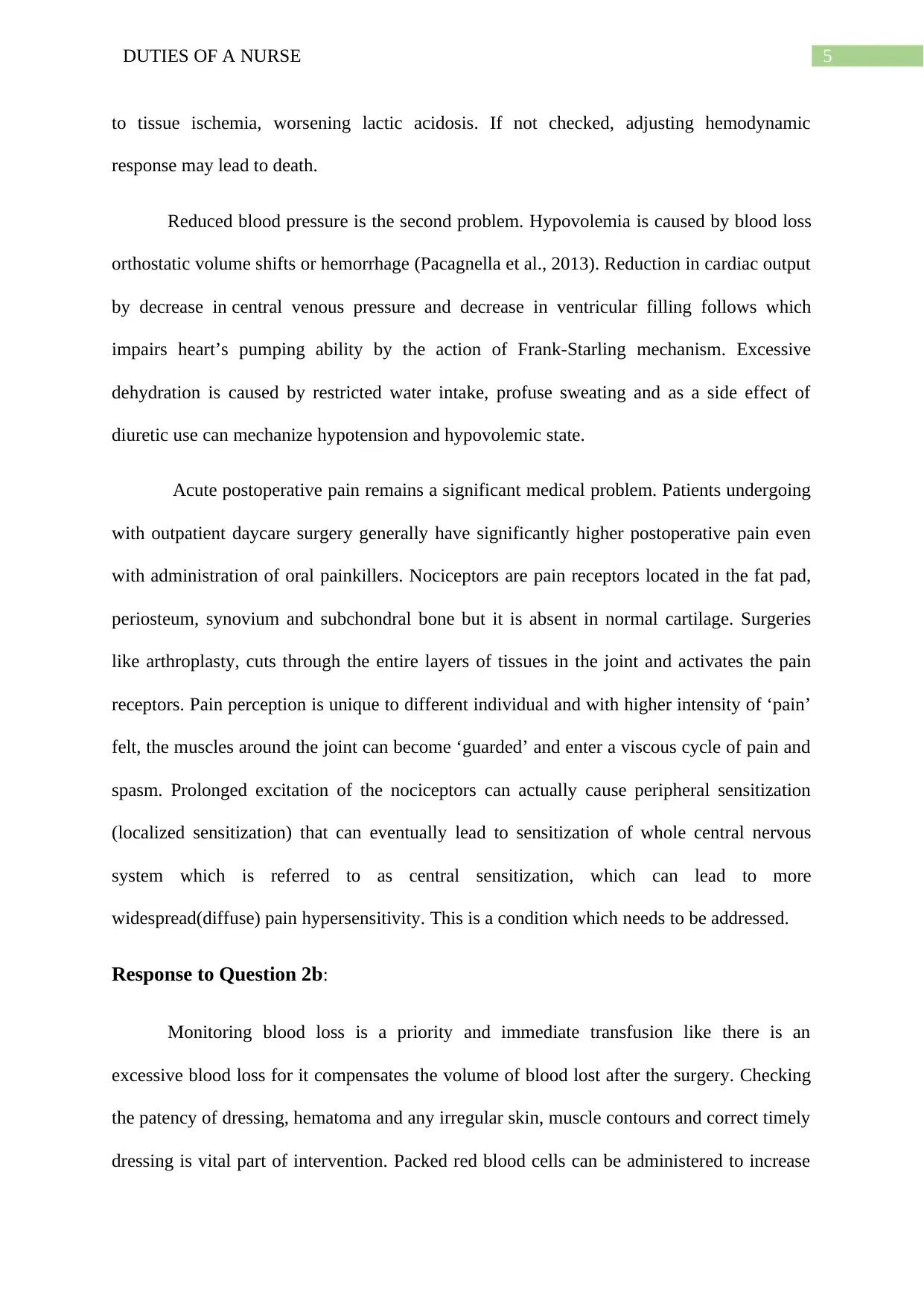
5DUTIES OF A NURSE
to tissue ischemia, worsening lactic acidosis. If not checked, adjusting hemodynamic
response may lead to death.
Reduced blood pressure is the second problem. Hypovolemia is caused by blood loss
orthostatic volume shifts or hemorrhage (Pacagnella et al., 2013). Reduction in cardiac output
by decrease in central venous pressure and decrease in ventricular filling follows which
impairs heart’s pumping ability by the action of Frank-Starling mechanism. Excessive
dehydration is caused by restricted water intake, profuse sweating and as a side effect of
diuretic use can mechanize hypotension and hypovolemic state.
Acute postoperative pain remains a significant medical problem. Patients undergoing
with outpatient daycare surgery generally have significantly higher postoperative pain even
with administration of oral painkillers. Nociceptors are pain receptors located in the fat pad,
periosteum, synovium and subchondral bone but it is absent in normal cartilage. Surgeries
like arthroplasty, cuts through the entire layers of tissues in the joint and activates the pain
receptors. Pain perception is unique to different individual and with higher intensity of ‘pain’
felt, the muscles around the joint can become ‘guarded’ and enter a viscous cycle of pain and
spasm. Prolonged excitation of the nociceptors can actually cause peripheral sensitization
(localized sensitization) that can eventually lead to sensitization of whole central nervous
system which is referred to as central sensitization, which can lead to more
widespread(diffuse) pain hypersensitivity. This is a condition which needs to be addressed.
Response to Question 2b:
Monitoring blood loss is a priority and immediate transfusion like there is an
excessive blood loss for it compensates the volume of blood lost after the surgery. Checking
the patency of dressing, hematoma and any irregular skin, muscle contours and correct timely
dressing is vital part of intervention. Packed red blood cells can be administered to increase
to tissue ischemia, worsening lactic acidosis. If not checked, adjusting hemodynamic
response may lead to death.
Reduced blood pressure is the second problem. Hypovolemia is caused by blood loss
orthostatic volume shifts or hemorrhage (Pacagnella et al., 2013). Reduction in cardiac output
by decrease in central venous pressure and decrease in ventricular filling follows which
impairs heart’s pumping ability by the action of Frank-Starling mechanism. Excessive
dehydration is caused by restricted water intake, profuse sweating and as a side effect of
diuretic use can mechanize hypotension and hypovolemic state.
Acute postoperative pain remains a significant medical problem. Patients undergoing
with outpatient daycare surgery generally have significantly higher postoperative pain even
with administration of oral painkillers. Nociceptors are pain receptors located in the fat pad,
periosteum, synovium and subchondral bone but it is absent in normal cartilage. Surgeries
like arthroplasty, cuts through the entire layers of tissues in the joint and activates the pain
receptors. Pain perception is unique to different individual and with higher intensity of ‘pain’
felt, the muscles around the joint can become ‘guarded’ and enter a viscous cycle of pain and
spasm. Prolonged excitation of the nociceptors can actually cause peripheral sensitization
(localized sensitization) that can eventually lead to sensitization of whole central nervous
system which is referred to as central sensitization, which can lead to more
widespread(diffuse) pain hypersensitivity. This is a condition which needs to be addressed.
Response to Question 2b:
Monitoring blood loss is a priority and immediate transfusion like there is an
excessive blood loss for it compensates the volume of blood lost after the surgery. Checking
the patency of dressing, hematoma and any irregular skin, muscle contours and correct timely
dressing is vital part of intervention. Packed red blood cells can be administered to increase
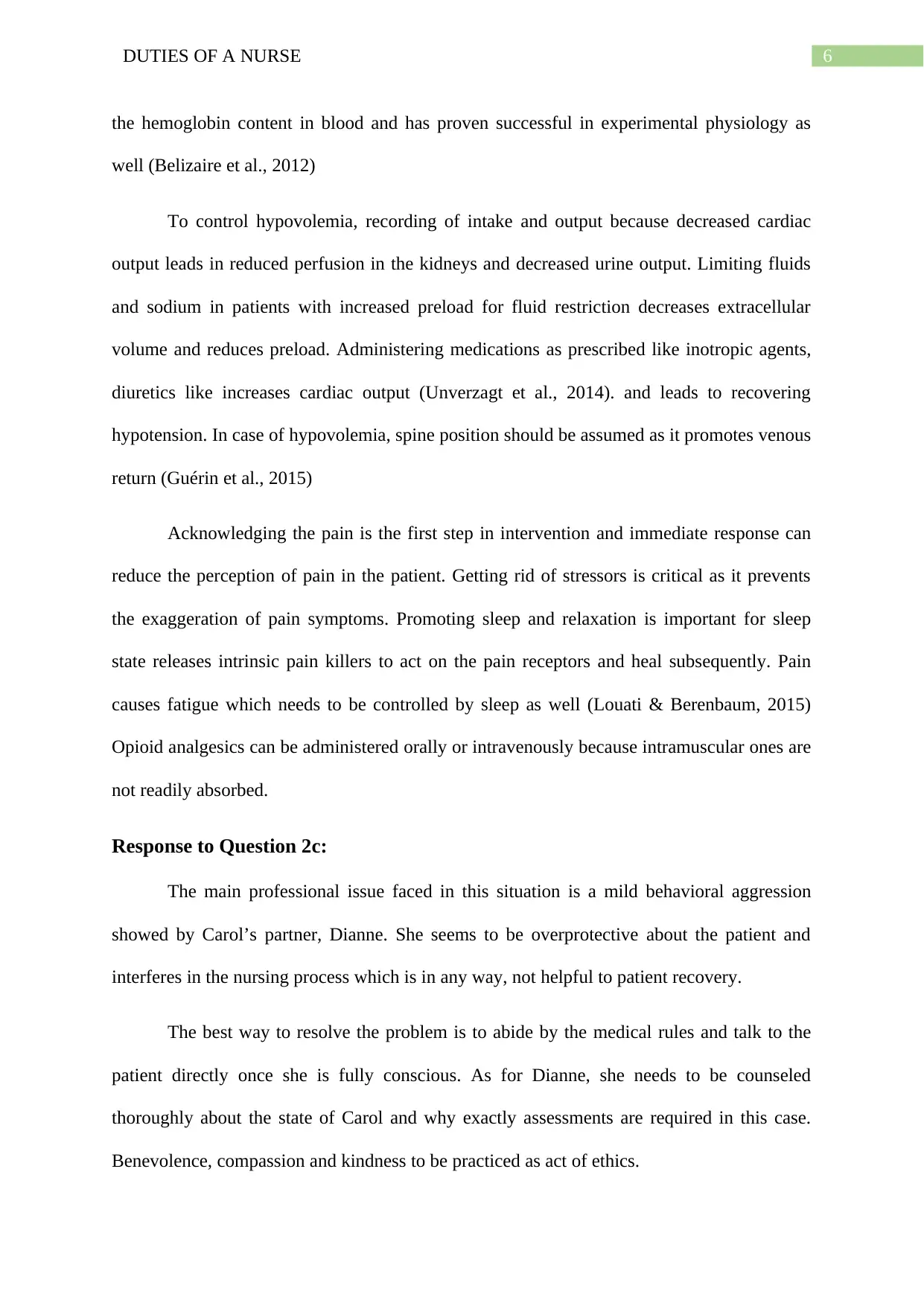
6DUTIES OF A NURSE
the hemoglobin content in blood and has proven successful in experimental physiology as
well (Belizaire et al., 2012)
To control hypovolemia, recording of intake and output because decreased cardiac
output leads in reduced perfusion in the kidneys and decreased urine output. Limiting fluids
and sodium in patients with increased preload for fluid restriction decreases extracellular
volume and reduces preload. Administering medications as prescribed like inotropic agents,
diuretics like increases cardiac output (Unverzagt et al., 2014). and leads to recovering
hypotension. In case of hypovolemia, spine position should be assumed as it promotes venous
return (Guérin et al., 2015)
Acknowledging the pain is the first step in intervention and immediate response can
reduce the perception of pain in the patient. Getting rid of stressors is critical as it prevents
the exaggeration of pain symptoms. Promoting sleep and relaxation is important for sleep
state releases intrinsic pain killers to act on the pain receptors and heal subsequently. Pain
causes fatigue which needs to be controlled by sleep as well (Louati & Berenbaum, 2015)
Opioid analgesics can be administered orally or intravenously because intramuscular ones are
not readily absorbed.
Response to Question 2c:
The main professional issue faced in this situation is a mild behavioral aggression
showed by Carol’s partner, Dianne. She seems to be overprotective about the patient and
interferes in the nursing process which is in any way, not helpful to patient recovery.
The best way to resolve the problem is to abide by the medical rules and talk to the
patient directly once she is fully conscious. As for Dianne, she needs to be counseled
thoroughly about the state of Carol and why exactly assessments are required in this case.
Benevolence, compassion and kindness to be practiced as act of ethics.
the hemoglobin content in blood and has proven successful in experimental physiology as
well (Belizaire et al., 2012)
To control hypovolemia, recording of intake and output because decreased cardiac
output leads in reduced perfusion in the kidneys and decreased urine output. Limiting fluids
and sodium in patients with increased preload for fluid restriction decreases extracellular
volume and reduces preload. Administering medications as prescribed like inotropic agents,
diuretics like increases cardiac output (Unverzagt et al., 2014). and leads to recovering
hypotension. In case of hypovolemia, spine position should be assumed as it promotes venous
return (Guérin et al., 2015)
Acknowledging the pain is the first step in intervention and immediate response can
reduce the perception of pain in the patient. Getting rid of stressors is critical as it prevents
the exaggeration of pain symptoms. Promoting sleep and relaxation is important for sleep
state releases intrinsic pain killers to act on the pain receptors and heal subsequently. Pain
causes fatigue which needs to be controlled by sleep as well (Louati & Berenbaum, 2015)
Opioid analgesics can be administered orally or intravenously because intramuscular ones are
not readily absorbed.
Response to Question 2c:
The main professional issue faced in this situation is a mild behavioral aggression
showed by Carol’s partner, Dianne. She seems to be overprotective about the patient and
interferes in the nursing process which is in any way, not helpful to patient recovery.
The best way to resolve the problem is to abide by the medical rules and talk to the
patient directly once she is fully conscious. As for Dianne, she needs to be counseled
thoroughly about the state of Carol and why exactly assessments are required in this case.
Benevolence, compassion and kindness to be practiced as act of ethics.
Paraphrase This Document
Need a fresh take? Get an instant paraphrase of this document with our AI Paraphraser
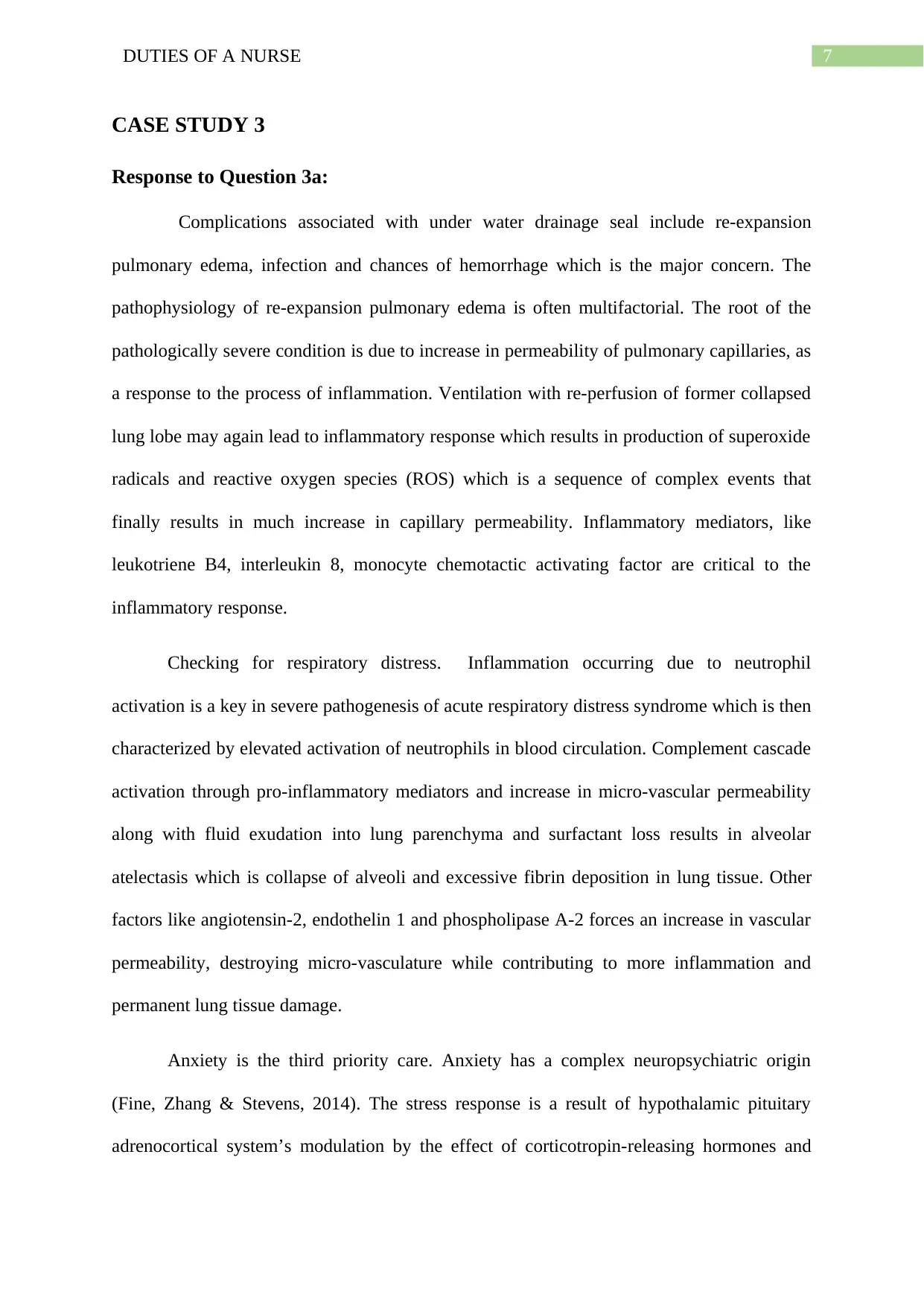
7DUTIES OF A NURSE
CASE STUDY 3
Response to Question 3a:
Complications associated with under water drainage seal include re-expansion
pulmonary edema, infection and chances of hemorrhage which is the major concern. The
pathophysiology of re-expansion pulmonary edema is often multifactorial. The root of the
pathologically severe condition is due to increase in permeability of pulmonary capillaries, as
a response to the process of inflammation. Ventilation with re-perfusion of former collapsed
lung lobe may again lead to inflammatory response which results in production of superoxide
radicals and reactive oxygen species (ROS) which is a sequence of complex events that
finally results in much increase in capillary permeability. Inflammatory mediators, like
leukotriene B4, interleukin 8, monocyte chemotactic activating factor are critical to the
inflammatory response.
Checking for respiratory distress. Inflammation occurring due to neutrophil
activation is a key in severe pathogenesis of acute respiratory distress syndrome which is then
characterized by elevated activation of neutrophils in blood circulation. Complement cascade
activation through pro-inflammatory mediators and increase in micro-vascular permeability
along with fluid exudation into lung parenchyma and surfactant loss results in alveolar
atelectasis which is collapse of alveoli and excessive fibrin deposition in lung tissue. Other
factors like angiotensin-2, endothelin 1 and phospholipase A-2 forces an increase in vascular
permeability, destroying micro-vasculature while contributing to more inflammation and
permanent lung tissue damage.
Anxiety is the third priority care. Anxiety has a complex neuropsychiatric origin
(Fine, Zhang & Stevens, 2014). The stress response is a result of hypothalamic pituitary
adrenocortical system’s modulation by the effect of corticotropin-releasing hormones and
CASE STUDY 3
Response to Question 3a:
Complications associated with under water drainage seal include re-expansion
pulmonary edema, infection and chances of hemorrhage which is the major concern. The
pathophysiology of re-expansion pulmonary edema is often multifactorial. The root of the
pathologically severe condition is due to increase in permeability of pulmonary capillaries, as
a response to the process of inflammation. Ventilation with re-perfusion of former collapsed
lung lobe may again lead to inflammatory response which results in production of superoxide
radicals and reactive oxygen species (ROS) which is a sequence of complex events that
finally results in much increase in capillary permeability. Inflammatory mediators, like
leukotriene B4, interleukin 8, monocyte chemotactic activating factor are critical to the
inflammatory response.
Checking for respiratory distress. Inflammation occurring due to neutrophil
activation is a key in severe pathogenesis of acute respiratory distress syndrome which is then
characterized by elevated activation of neutrophils in blood circulation. Complement cascade
activation through pro-inflammatory mediators and increase in micro-vascular permeability
along with fluid exudation into lung parenchyma and surfactant loss results in alveolar
atelectasis which is collapse of alveoli and excessive fibrin deposition in lung tissue. Other
factors like angiotensin-2, endothelin 1 and phospholipase A-2 forces an increase in vascular
permeability, destroying micro-vasculature while contributing to more inflammation and
permanent lung tissue damage.
Anxiety is the third priority care. Anxiety has a complex neuropsychiatric origin
(Fine, Zhang & Stevens, 2014). The stress response is a result of hypothalamic pituitary
adrenocortical system’s modulation by the effect of corticotropin-releasing hormones and
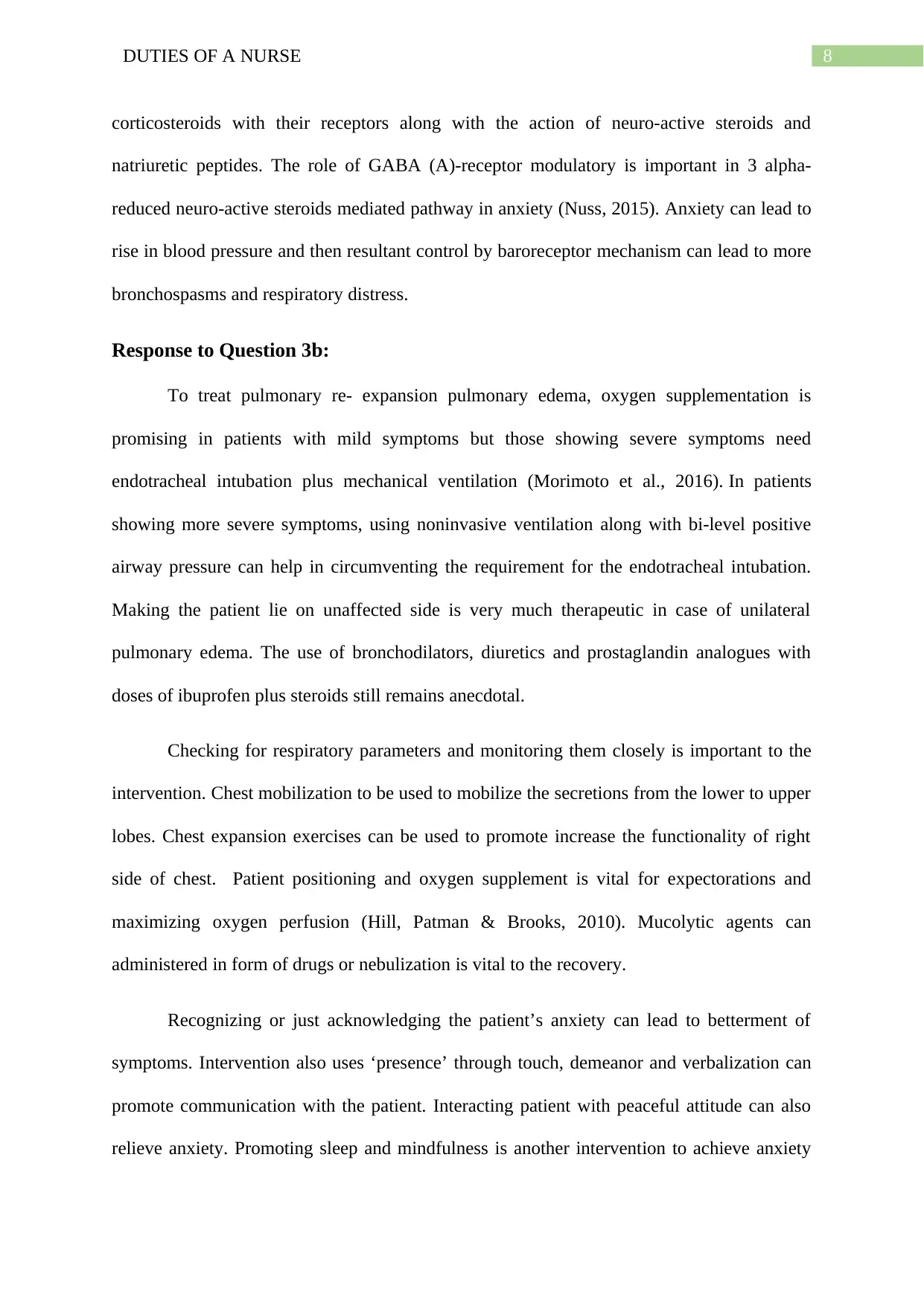
8DUTIES OF A NURSE
corticosteroids with their receptors along with the action of neuro-active steroids and
natriuretic peptides. The role of GABA (A)-receptor modulatory is important in 3 alpha-
reduced neuro-active steroids mediated pathway in anxiety (Nuss, 2015). Anxiety can lead to
rise in blood pressure and then resultant control by baroreceptor mechanism can lead to more
bronchospasms and respiratory distress.
Response to Question 3b:
To treat pulmonary re- expansion pulmonary edema, oxygen supplementation is
promising in patients with mild symptoms but those showing severe symptoms need
endotracheal intubation plus mechanical ventilation (Morimoto et al., 2016). In patients
showing more severe symptoms, using noninvasive ventilation along with bi-level positive
airway pressure can help in circumventing the requirement for the endotracheal intubation.
Making the patient lie on unaffected side is very much therapeutic in case of unilateral
pulmonary edema. The use of bronchodilators, diuretics and prostaglandin analogues with
doses of ibuprofen plus steroids still remains anecdotal.
Checking for respiratory parameters and monitoring them closely is important to the
intervention. Chest mobilization to be used to mobilize the secretions from the lower to upper
lobes. Chest expansion exercises can be used to promote increase the functionality of right
side of chest. Patient positioning and oxygen supplement is vital for expectorations and
maximizing oxygen perfusion (Hill, Patman & Brooks, 2010). Mucolytic agents can
administered in form of drugs or nebulization is vital to the recovery.
Recognizing or just acknowledging the patient’s anxiety can lead to betterment of
symptoms. Intervention also uses ‘presence’ through touch, demeanor and verbalization can
promote communication with the patient. Interacting patient with peaceful attitude can also
relieve anxiety. Promoting sleep and mindfulness is another intervention to achieve anxiety
corticosteroids with their receptors along with the action of neuro-active steroids and
natriuretic peptides. The role of GABA (A)-receptor modulatory is important in 3 alpha-
reduced neuro-active steroids mediated pathway in anxiety (Nuss, 2015). Anxiety can lead to
rise in blood pressure and then resultant control by baroreceptor mechanism can lead to more
bronchospasms and respiratory distress.
Response to Question 3b:
To treat pulmonary re- expansion pulmonary edema, oxygen supplementation is
promising in patients with mild symptoms but those showing severe symptoms need
endotracheal intubation plus mechanical ventilation (Morimoto et al., 2016). In patients
showing more severe symptoms, using noninvasive ventilation along with bi-level positive
airway pressure can help in circumventing the requirement for the endotracheal intubation.
Making the patient lie on unaffected side is very much therapeutic in case of unilateral
pulmonary edema. The use of bronchodilators, diuretics and prostaglandin analogues with
doses of ibuprofen plus steroids still remains anecdotal.
Checking for respiratory parameters and monitoring them closely is important to the
intervention. Chest mobilization to be used to mobilize the secretions from the lower to upper
lobes. Chest expansion exercises can be used to promote increase the functionality of right
side of chest. Patient positioning and oxygen supplement is vital for expectorations and
maximizing oxygen perfusion (Hill, Patman & Brooks, 2010). Mucolytic agents can
administered in form of drugs or nebulization is vital to the recovery.
Recognizing or just acknowledging the patient’s anxiety can lead to betterment of
symptoms. Intervention also uses ‘presence’ through touch, demeanor and verbalization can
promote communication with the patient. Interacting patient with peaceful attitude can also
relieve anxiety. Promoting sleep and mindfulness is another intervention to achieve anxiety
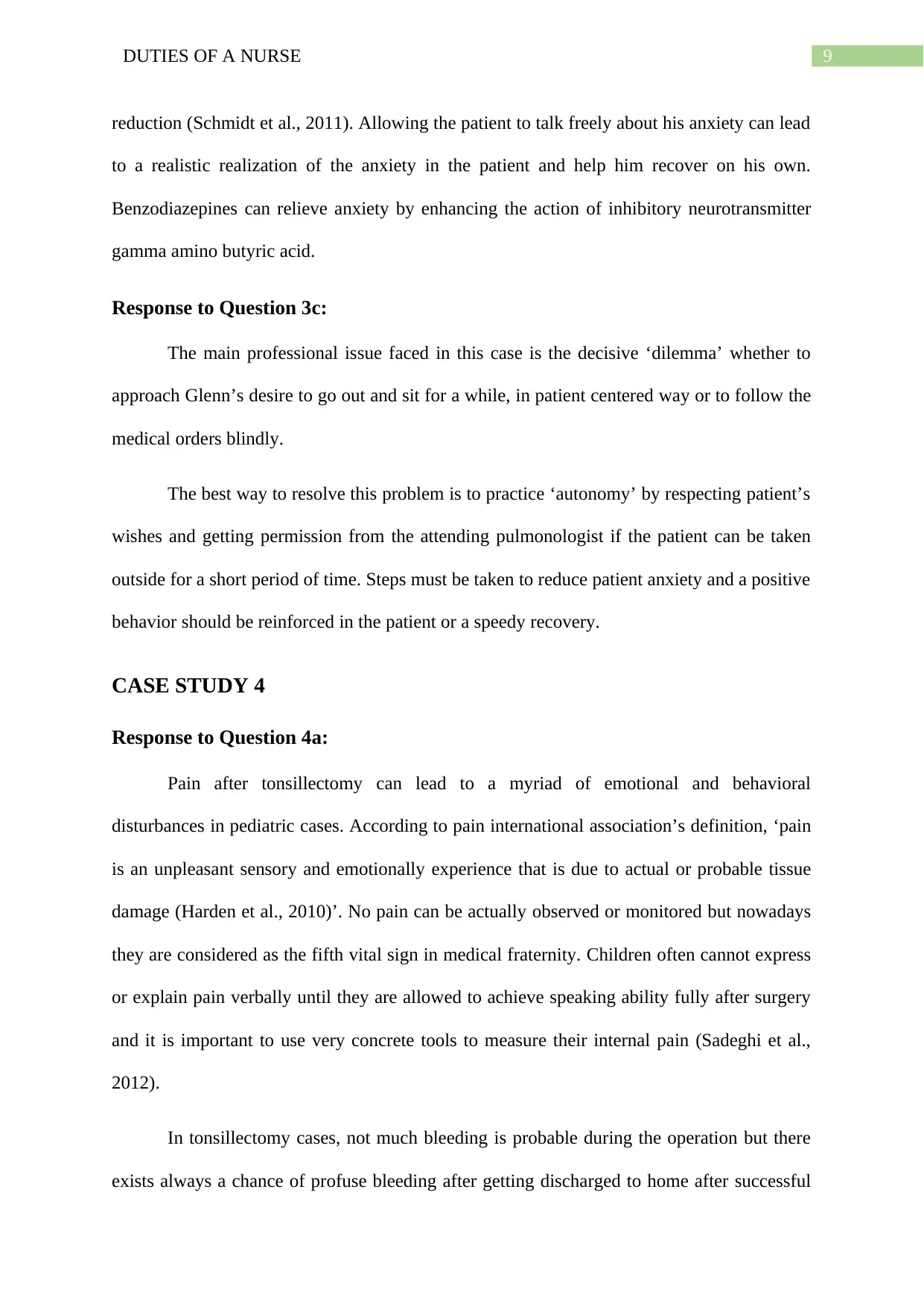
9DUTIES OF A NURSE
reduction (Schmidt et al., 2011). Allowing the patient to talk freely about his anxiety can lead
to a realistic realization of the anxiety in the patient and help him recover on his own.
Benzodiazepines can relieve anxiety by enhancing the action of inhibitory neurotransmitter
gamma amino butyric acid.
Response to Question 3c:
The main professional issue faced in this case is the decisive ‘dilemma’ whether to
approach Glenn’s desire to go out and sit for a while, in patient centered way or to follow the
medical orders blindly.
The best way to resolve this problem is to practice ‘autonomy’ by respecting patient’s
wishes and getting permission from the attending pulmonologist if the patient can be taken
outside for a short period of time. Steps must be taken to reduce patient anxiety and a positive
behavior should be reinforced in the patient or a speedy recovery.
CASE STUDY 4
Response to Question 4a:
Pain after tonsillectomy can lead to a myriad of emotional and behavioral
disturbances in pediatric cases. According to pain international association’s definition, ‘pain
is an unpleasant sensory and emotionally experience that is due to actual or probable tissue
damage (Harden et al., 2010)’. No pain can be actually observed or monitored but nowadays
they are considered as the fifth vital sign in medical fraternity. Children often cannot express
or explain pain verbally until they are allowed to achieve speaking ability fully after surgery
and it is important to use very concrete tools to measure their internal pain (Sadeghi et al.,
2012).
In tonsillectomy cases, not much bleeding is probable during the operation but there
exists always a chance of profuse bleeding after getting discharged to home after successful
reduction (Schmidt et al., 2011). Allowing the patient to talk freely about his anxiety can lead
to a realistic realization of the anxiety in the patient and help him recover on his own.
Benzodiazepines can relieve anxiety by enhancing the action of inhibitory neurotransmitter
gamma amino butyric acid.
Response to Question 3c:
The main professional issue faced in this case is the decisive ‘dilemma’ whether to
approach Glenn’s desire to go out and sit for a while, in patient centered way or to follow the
medical orders blindly.
The best way to resolve this problem is to practice ‘autonomy’ by respecting patient’s
wishes and getting permission from the attending pulmonologist if the patient can be taken
outside for a short period of time. Steps must be taken to reduce patient anxiety and a positive
behavior should be reinforced in the patient or a speedy recovery.
CASE STUDY 4
Response to Question 4a:
Pain after tonsillectomy can lead to a myriad of emotional and behavioral
disturbances in pediatric cases. According to pain international association’s definition, ‘pain
is an unpleasant sensory and emotionally experience that is due to actual or probable tissue
damage (Harden et al., 2010)’. No pain can be actually observed or monitored but nowadays
they are considered as the fifth vital sign in medical fraternity. Children often cannot express
or explain pain verbally until they are allowed to achieve speaking ability fully after surgery
and it is important to use very concrete tools to measure their internal pain (Sadeghi et al.,
2012).
In tonsillectomy cases, not much bleeding is probable during the operation but there
exists always a chance of profuse bleeding after getting discharged to home after successful
Secure Best Marks with AI Grader
Need help grading? Try our AI Grader for instant feedback on your assignments.

10DUTIES OF A NURSE
operation. Common time for bleeding once tonsillectomy is performed is about 4 to10 days.
Blood loss is potential problem. Bleeding can lead to activation of more severe inflammatory
response aggravating the normal process of post-surgical healing.
Surgery with anesthesia can cause neurosis and anxiety to great extent in children
along with caring parents. It is clear that the management should focus on decreasing their
level of anxiety while promoting relaxation is crucial because it can prevent distressing and
irreversible mental consequences. Eliminating or minimizing children’s anxiety actually leads
to better healing and improvement of outcome.
Response to Question 4b:
Using cold compress to relieve jaw and neck pain is also one of the instructions used
in studies of both Rotenberg (2013) and Shin (2014) to confirm the issue. Ice collar program
can be used in pain relief following post-tonsillectomy and ice therapy can also be used
because application of ice causes Lewis-hunting reaction leading to vasoconstriction and
vasodilation episodes resulting in increased blood circulation and nutrient exchange around
capillaries helps in fast recovery (Mekjavic, Dobnikar & Kounalakis, 2012)
Hemorrhage needs to be monitored continuously by checking sputum and cough
droplets. Hemodynamics monitoring is a vital intervention. In case of blood loss, blood
transfusion should be started at once to compensate for the blood loss. Bleeding site needs to
checked, stitched or the cause of bleeding needs to deduced quickly so as to prevent the
severity and extent of blood loss. Educating the patient about not coughing and other
measures can prevent the risks of bleeding. Normal saline should be used to maintain fluid
balance (Prowle et al., 2010) and accelerate the process of tissue repair and healing.
Anxiety acknowledgement, compassion, kindness and empathic counselling can
reduce the extent of anxiety in the child (Jansen et al., 2010). Promoting breathing exercises
operation. Common time for bleeding once tonsillectomy is performed is about 4 to10 days.
Blood loss is potential problem. Bleeding can lead to activation of more severe inflammatory
response aggravating the normal process of post-surgical healing.
Surgery with anesthesia can cause neurosis and anxiety to great extent in children
along with caring parents. It is clear that the management should focus on decreasing their
level of anxiety while promoting relaxation is crucial because it can prevent distressing and
irreversible mental consequences. Eliminating or minimizing children’s anxiety actually leads
to better healing and improvement of outcome.
Response to Question 4b:
Using cold compress to relieve jaw and neck pain is also one of the instructions used
in studies of both Rotenberg (2013) and Shin (2014) to confirm the issue. Ice collar program
can be used in pain relief following post-tonsillectomy and ice therapy can also be used
because application of ice causes Lewis-hunting reaction leading to vasoconstriction and
vasodilation episodes resulting in increased blood circulation and nutrient exchange around
capillaries helps in fast recovery (Mekjavic, Dobnikar & Kounalakis, 2012)
Hemorrhage needs to be monitored continuously by checking sputum and cough
droplets. Hemodynamics monitoring is a vital intervention. In case of blood loss, blood
transfusion should be started at once to compensate for the blood loss. Bleeding site needs to
checked, stitched or the cause of bleeding needs to deduced quickly so as to prevent the
severity and extent of blood loss. Educating the patient about not coughing and other
measures can prevent the risks of bleeding. Normal saline should be used to maintain fluid
balance (Prowle et al., 2010) and accelerate the process of tissue repair and healing.
Anxiety acknowledgement, compassion, kindness and empathic counselling can
reduce the extent of anxiety in the child (Jansen et al., 2010). Promoting breathing exercises
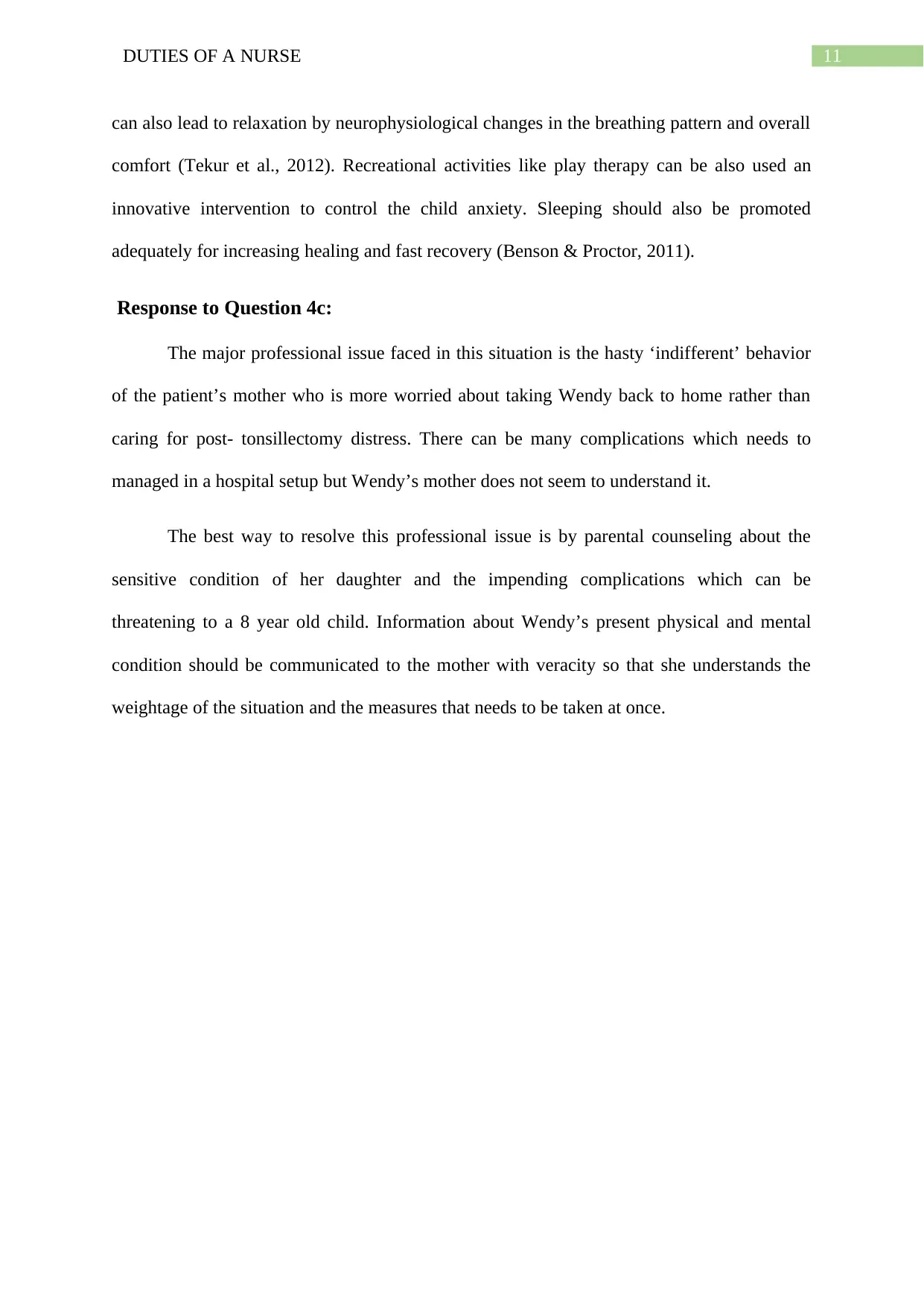
11DUTIES OF A NURSE
can also lead to relaxation by neurophysiological changes in the breathing pattern and overall
comfort (Tekur et al., 2012). Recreational activities like play therapy can be also used an
innovative intervention to control the child anxiety. Sleeping should also be promoted
adequately for increasing healing and fast recovery (Benson & Proctor, 2011).
Response to Question 4c:
The major professional issue faced in this situation is the hasty ‘indifferent’ behavior
of the patient’s mother who is more worried about taking Wendy back to home rather than
caring for post- tonsillectomy distress. There can be many complications which needs to
managed in a hospital setup but Wendy’s mother does not seem to understand it.
The best way to resolve this professional issue is by parental counseling about the
sensitive condition of her daughter and the impending complications which can be
threatening to a 8 year old child. Information about Wendy’s present physical and mental
condition should be communicated to the mother with veracity so that she understands the
weightage of the situation and the measures that needs to be taken at once.
can also lead to relaxation by neurophysiological changes in the breathing pattern and overall
comfort (Tekur et al., 2012). Recreational activities like play therapy can be also used an
innovative intervention to control the child anxiety. Sleeping should also be promoted
adequately for increasing healing and fast recovery (Benson & Proctor, 2011).
Response to Question 4c:
The major professional issue faced in this situation is the hasty ‘indifferent’ behavior
of the patient’s mother who is more worried about taking Wendy back to home rather than
caring for post- tonsillectomy distress. There can be many complications which needs to
managed in a hospital setup but Wendy’s mother does not seem to understand it.
The best way to resolve this professional issue is by parental counseling about the
sensitive condition of her daughter and the impending complications which can be
threatening to a 8 year old child. Information about Wendy’s present physical and mental
condition should be communicated to the mother with veracity so that she understands the
weightage of the situation and the measures that needs to be taken at once.
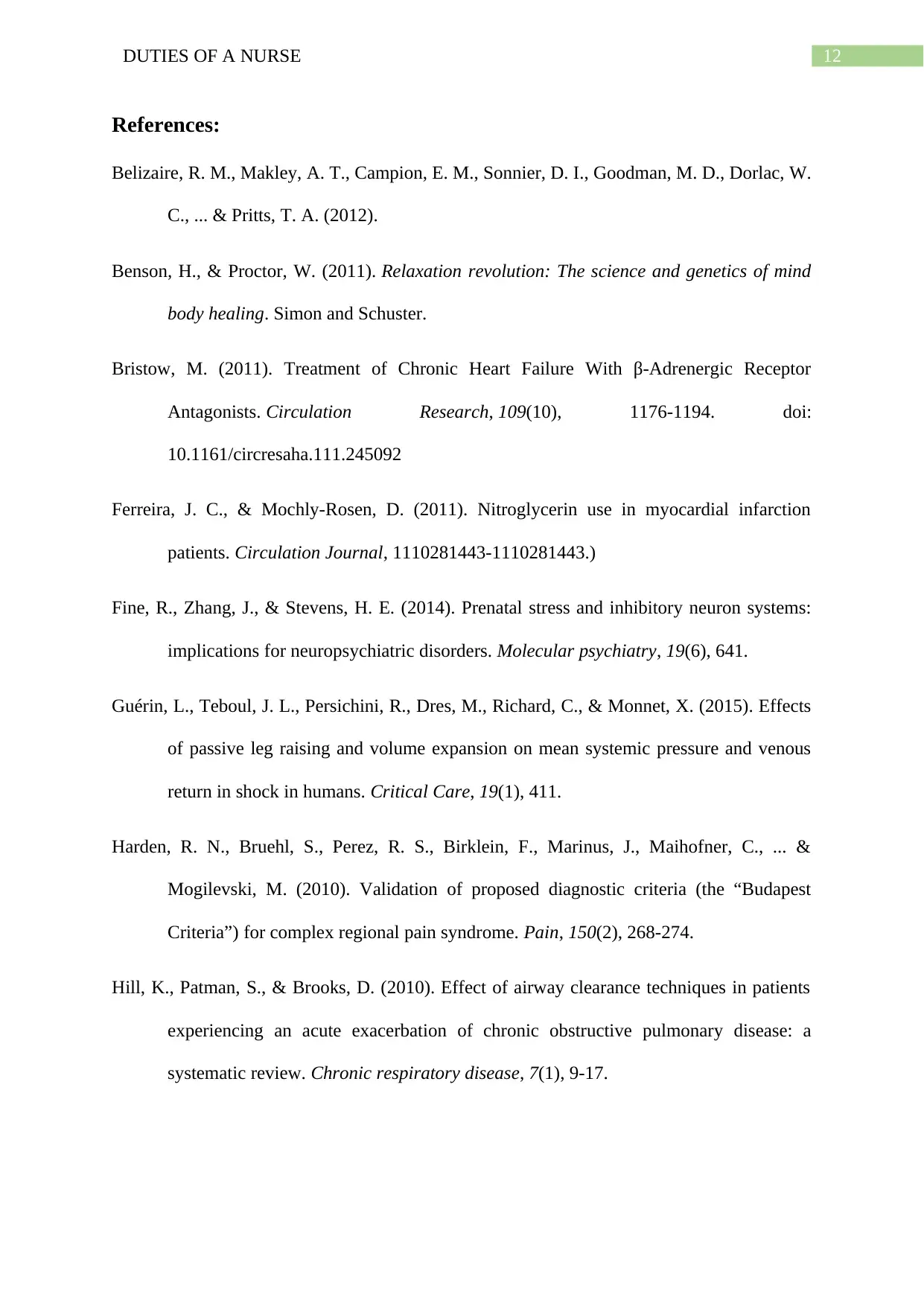
12DUTIES OF A NURSE
References:
Belizaire, R. M., Makley, A. T., Campion, E. M., Sonnier, D. I., Goodman, M. D., Dorlac, W.
C., ... & Pritts, T. A. (2012).
Benson, H., & Proctor, W. (2011). Relaxation revolution: The science and genetics of mind
body healing. Simon and Schuster.
Bristow, M. (2011). Treatment of Chronic Heart Failure With β-Adrenergic Receptor
Antagonists. Circulation Research, 109(10), 1176-1194. doi:
10.1161/circresaha.111.245092
Ferreira, J. C., & Mochly-Rosen, D. (2011). Nitroglycerin use in myocardial infarction
patients. Circulation Journal, 1110281443-1110281443.)
Fine, R., Zhang, J., & Stevens, H. E. (2014). Prenatal stress and inhibitory neuron systems:
implications for neuropsychiatric disorders. Molecular psychiatry, 19(6), 641.
Guérin, L., Teboul, J. L., Persichini, R., Dres, M., Richard, C., & Monnet, X. (2015). Effects
of passive leg raising and volume expansion on mean systemic pressure and venous
return in shock in humans. Critical Care, 19(1), 411.
Harden, R. N., Bruehl, S., Perez, R. S., Birklein, F., Marinus, J., Maihofner, C., ... &
Mogilevski, M. (2010). Validation of proposed diagnostic criteria (the “Budapest
Criteria”) for complex regional pain syndrome. Pain, 150(2), 268-274.
Hill, K., Patman, S., & Brooks, D. (2010). Effect of airway clearance techniques in patients
experiencing an acute exacerbation of chronic obstructive pulmonary disease: a
systematic review. Chronic respiratory disease, 7(1), 9-17.
References:
Belizaire, R. M., Makley, A. T., Campion, E. M., Sonnier, D. I., Goodman, M. D., Dorlac, W.
C., ... & Pritts, T. A. (2012).
Benson, H., & Proctor, W. (2011). Relaxation revolution: The science and genetics of mind
body healing. Simon and Schuster.
Bristow, M. (2011). Treatment of Chronic Heart Failure With β-Adrenergic Receptor
Antagonists. Circulation Research, 109(10), 1176-1194. doi:
10.1161/circresaha.111.245092
Ferreira, J. C., & Mochly-Rosen, D. (2011). Nitroglycerin use in myocardial infarction
patients. Circulation Journal, 1110281443-1110281443.)
Fine, R., Zhang, J., & Stevens, H. E. (2014). Prenatal stress and inhibitory neuron systems:
implications for neuropsychiatric disorders. Molecular psychiatry, 19(6), 641.
Guérin, L., Teboul, J. L., Persichini, R., Dres, M., Richard, C., & Monnet, X. (2015). Effects
of passive leg raising and volume expansion on mean systemic pressure and venous
return in shock in humans. Critical Care, 19(1), 411.
Harden, R. N., Bruehl, S., Perez, R. S., Birklein, F., Marinus, J., Maihofner, C., ... &
Mogilevski, M. (2010). Validation of proposed diagnostic criteria (the “Budapest
Criteria”) for complex regional pain syndrome. Pain, 150(2), 268-274.
Hill, K., Patman, S., & Brooks, D. (2010). Effect of airway clearance techniques in patients
experiencing an acute exacerbation of chronic obstructive pulmonary disease: a
systematic review. Chronic respiratory disease, 7(1), 9-17.
Paraphrase This Document
Need a fresh take? Get an instant paraphrase of this document with our AI Paraphraser

13DUTIES OF A NURSE
Jansen, J., van Weert, J. C., de Groot, J., van Dulmen, S., Heeren, T. J., & Bensing, J. M.
(2010). Emotional and informational patient cues: the impact of nurses’ responses on
recall. Patient education and counseling, 79(2), 218-224.
Louati, K., & Berenbaum, F. (2015). Fatigue in chronic inflammation-a link to pain
pathways. Arthritis research & therapy, 17(1), 254.
Masoompour, S. M., Anushiravani, A., & Norouz, A. T. (2015). Evaluation of the effect of
nebulized N-acetylcysteine on respiratory secretions in mechanically ventilated
patients: randomized clinical trial. Iranian journal of medical sciences, 40(4), 309.
Mekjavic, I. B., Dobnikar, U., & Kounalakis, S. N. (2012). Cold-induced vasodilatation
response in the fingers at 4 different water temperatures. Applied physiology,
nutrition, and metabolism, 38(999), 14-20
Morimoto, Y., Sugimoto, T., Arase, H., & Haba, F. (2016). Successful management using
airway pressure release ventilation for severe postoperative pulmonary
edema. International journal of surgery case reports, 27, 93-95.
Nuss, P. (2015). Anxiety disorders and GABA neurotransmission: a disturbance of
modulation. Neuropsychiatric disease and treatment, 11, 165.
Pacagnella, R. C., Souza, J. P., Durocher, J., Perel, P., Blum, J., Winikoff, B., & Gülmezoglu,
A. M. (2013). A systematic review of the relationship between blood loss and clinical
signs. Plos one, 8(3), e57594.
Panchabhai, T. S., Bandyopadhyay, D., Highland, K. B., Chaisson, N. F., & Aboussouan, L.
S. (2016). A 26-Year-Old Woman With Systemic Lupus Erythematosus Presenting
With Orthopnea and Restrictive Lung Impairment. Chest, 149(1), e29-e33.
Jansen, J., van Weert, J. C., de Groot, J., van Dulmen, S., Heeren, T. J., & Bensing, J. M.
(2010). Emotional and informational patient cues: the impact of nurses’ responses on
recall. Patient education and counseling, 79(2), 218-224.
Louati, K., & Berenbaum, F. (2015). Fatigue in chronic inflammation-a link to pain
pathways. Arthritis research & therapy, 17(1), 254.
Masoompour, S. M., Anushiravani, A., & Norouz, A. T. (2015). Evaluation of the effect of
nebulized N-acetylcysteine on respiratory secretions in mechanically ventilated
patients: randomized clinical trial. Iranian journal of medical sciences, 40(4), 309.
Mekjavic, I. B., Dobnikar, U., & Kounalakis, S. N. (2012). Cold-induced vasodilatation
response in the fingers at 4 different water temperatures. Applied physiology,
nutrition, and metabolism, 38(999), 14-20
Morimoto, Y., Sugimoto, T., Arase, H., & Haba, F. (2016). Successful management using
airway pressure release ventilation for severe postoperative pulmonary
edema. International journal of surgery case reports, 27, 93-95.
Nuss, P. (2015). Anxiety disorders and GABA neurotransmission: a disturbance of
modulation. Neuropsychiatric disease and treatment, 11, 165.
Pacagnella, R. C., Souza, J. P., Durocher, J., Perel, P., Blum, J., Winikoff, B., & Gülmezoglu,
A. M. (2013). A systematic review of the relationship between blood loss and clinical
signs. Plos one, 8(3), e57594.
Panchabhai, T. S., Bandyopadhyay, D., Highland, K. B., Chaisson, N. F., & Aboussouan, L.
S. (2016). A 26-Year-Old Woman With Systemic Lupus Erythematosus Presenting
With Orthopnea and Restrictive Lung Impairment. Chest, 149(1), e29-e33.
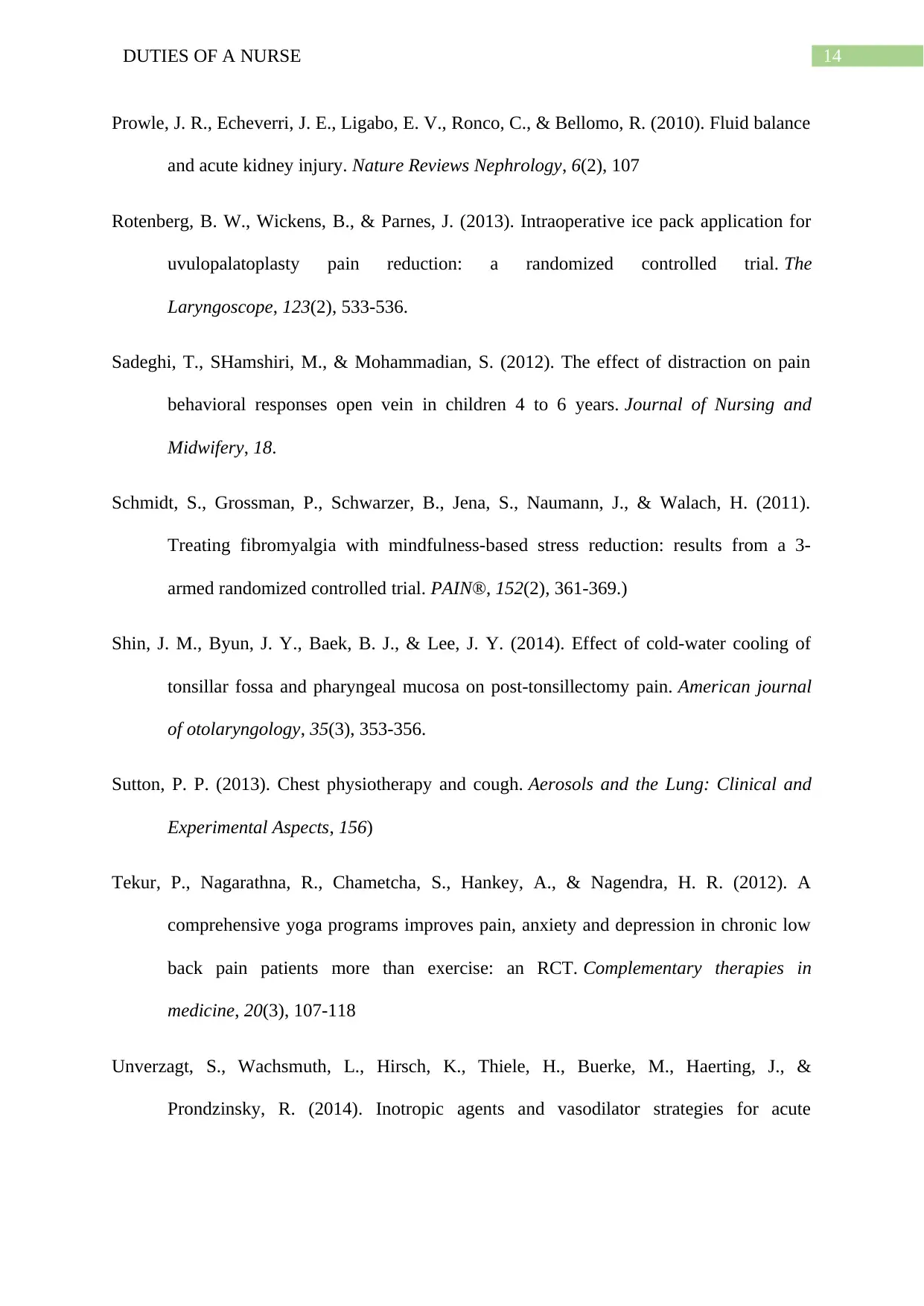
14DUTIES OF A NURSE
Prowle, J. R., Echeverri, J. E., Ligabo, E. V., Ronco, C., & Bellomo, R. (2010). Fluid balance
and acute kidney injury. Nature Reviews Nephrology, 6(2), 107
Rotenberg, B. W., Wickens, B., & Parnes, J. (2013). Intraoperative ice pack application for
uvulopalatoplasty pain reduction: a randomized controlled trial. The
Laryngoscope, 123(2), 533-536.
Sadeghi, T., SHamshiri, M., & Mohammadian, S. (2012). The effect of distraction on pain
behavioral responses open vein in children 4 to 6 years. Journal of Nursing and
Midwifery, 18.
Schmidt, S., Grossman, P., Schwarzer, B., Jena, S., Naumann, J., & Walach, H. (2011).
Treating fibromyalgia with mindfulness-based stress reduction: results from a 3-
armed randomized controlled trial. PAIN®, 152(2), 361-369.)
Shin, J. M., Byun, J. Y., Baek, B. J., & Lee, J. Y. (2014). Effect of cold-water cooling of
tonsillar fossa and pharyngeal mucosa on post-tonsillectomy pain. American journal
of otolaryngology, 35(3), 353-356.
Sutton, P. P. (2013). Chest physiotherapy and cough. Aerosols and the Lung: Clinical and
Experimental Aspects, 156)
Tekur, P., Nagarathna, R., Chametcha, S., Hankey, A., & Nagendra, H. R. (2012). A
comprehensive yoga programs improves pain, anxiety and depression in chronic low
back pain patients more than exercise: an RCT. Complementary therapies in
medicine, 20(3), 107-118
Unverzagt, S., Wachsmuth, L., Hirsch, K., Thiele, H., Buerke, M., Haerting, J., &
Prondzinsky, R. (2014). Inotropic agents and vasodilator strategies for acute
Prowle, J. R., Echeverri, J. E., Ligabo, E. V., Ronco, C., & Bellomo, R. (2010). Fluid balance
and acute kidney injury. Nature Reviews Nephrology, 6(2), 107
Rotenberg, B. W., Wickens, B., & Parnes, J. (2013). Intraoperative ice pack application for
uvulopalatoplasty pain reduction: a randomized controlled trial. The
Laryngoscope, 123(2), 533-536.
Sadeghi, T., SHamshiri, M., & Mohammadian, S. (2012). The effect of distraction on pain
behavioral responses open vein in children 4 to 6 years. Journal of Nursing and
Midwifery, 18.
Schmidt, S., Grossman, P., Schwarzer, B., Jena, S., Naumann, J., & Walach, H. (2011).
Treating fibromyalgia with mindfulness-based stress reduction: results from a 3-
armed randomized controlled trial. PAIN®, 152(2), 361-369.)
Shin, J. M., Byun, J. Y., Baek, B. J., & Lee, J. Y. (2014). Effect of cold-water cooling of
tonsillar fossa and pharyngeal mucosa on post-tonsillectomy pain. American journal
of otolaryngology, 35(3), 353-356.
Sutton, P. P. (2013). Chest physiotherapy and cough. Aerosols and the Lung: Clinical and
Experimental Aspects, 156)
Tekur, P., Nagarathna, R., Chametcha, S., Hankey, A., & Nagendra, H. R. (2012). A
comprehensive yoga programs improves pain, anxiety and depression in chronic low
back pain patients more than exercise: an RCT. Complementary therapies in
medicine, 20(3), 107-118
Unverzagt, S., Wachsmuth, L., Hirsch, K., Thiele, H., Buerke, M., Haerting, J., &
Prondzinsky, R. (2014). Inotropic agents and vasodilator strategies for acute

15DUTIES OF A NURSE
myocardial infarction complicated by cardiogenic shock or low cardiac output
syndrome. Cochrane Database of Systematic Reviews, (1)
myocardial infarction complicated by cardiogenic shock or low cardiac output
syndrome. Cochrane Database of Systematic Reviews, (1)
Secure Best Marks with AI Grader
Need help grading? Try our AI Grader for instant feedback on your assignments.

16DUTIES OF A NURSE

17DUTIES OF A NURSE
1 out of 18
Related Documents
Your All-in-One AI-Powered Toolkit for Academic Success.
+13062052269
info@desklib.com
Available 24*7 on WhatsApp / Email
![[object Object]](/_next/static/media/star-bottom.7253800d.svg)
Unlock your academic potential
© 2024 | Zucol Services PVT LTD | All rights reserved.





